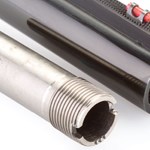
When it comes to optics for firearms, the specific terms that people use to describe them can be confusing. Here's what all that argot actually means—in alphabetical order, no less.
Ocular Lens
The ocular lens is positioned at the rear of the riflescope, closest to the shooter's eye. Normally, the ocular lens is smaller in diameter than the front or objective lens. The ocular lens assembly is threaded onto the main tube with a lock ring so it can be used to focus and hold a clear image by turning the entire assembly in or out. This enables the scope to accommodate individual visual preferences and reduces parallax (we'll get to that one shortly) at the given distance at which the scope is focused.
To focus a scope, first place a suitable paper target at the distance you wish to zero your rifle. Typically, most shooters select 50 yards for rimfire rifles and 100 or 200 yards for centerfire rifles. Next, mount the scope securely on your rifle and align it with the bore using one of any number of devices designed for the task, or, when possible, actually sighting through the bore itself. Now place the rifle in a solid rest, release the lock ring and move it forward. Turn the ocular assembly focus ring until you get a clear, crisp image of the paper target. keep going past the clear focus point until the target becomes blurred. Now reverse directions and go back just until the image is clear and crisp. Countertighten the lock ring to hold the assembly securely in position.
Parallax
Parallax occurs when the image of the target is not focused precisely on the plane of the reticle. This can be easily checked by placing your rifle in a solid rest, then moving your head up and down, then back and forth as you view the image in the scope. If the position of the crosshair appears to move on the target, parallax is present. If no parallax is present, the crosshair will appear to remain to remain stationary on the target. In a scope with parallax, the apparent point of aim changes with head position, making accurate shooting difficult. For this reason, it is desirable to eliminate as much parallax as possible.
Parallax can be completely eliminated only at one specific distance. This is why adjustable-objective scopes are popular with many shooters. Most hunting scopes, particularly less expensive models, have their parallax correction fixed at 100 or 150 yards. This compromise results in minimal parallax error at hunting ranges to 250 yards. Shotgun scopes are normally set for parallax correction at 50 yards.
Parallax remains one of the most common problems with riflescopes. Many new and used scopes exhibit excessive parallax, so always check a scope for parallax before you buy it.






































